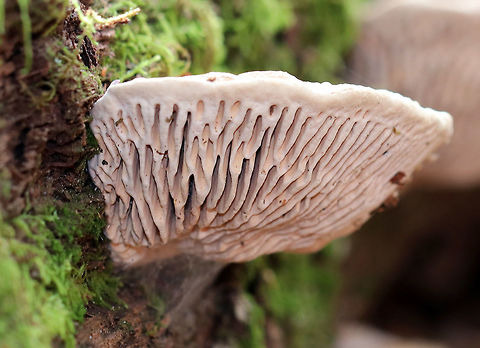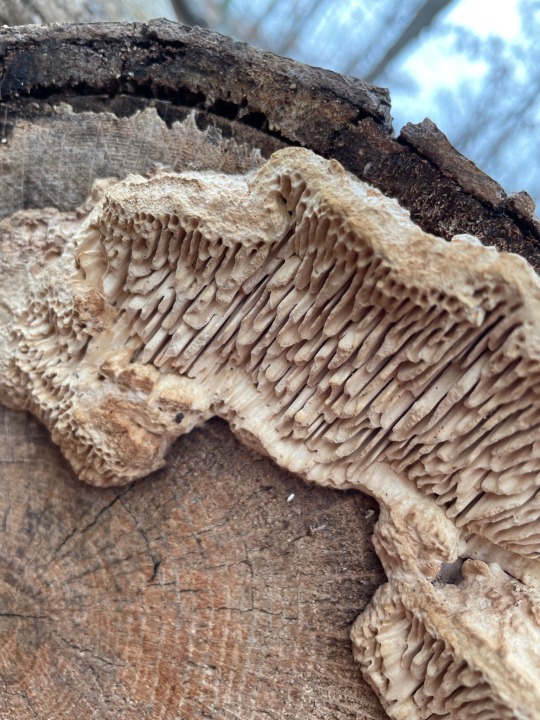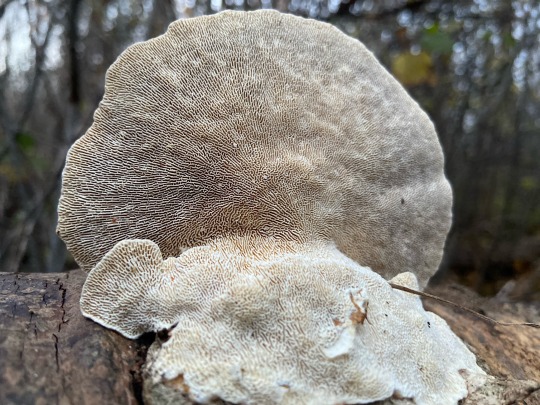#: oak mazegill :
Explore tagged Tumblr posts
Text
FOTD #131 : oak mazegill! (daedalea quercina)
oak mazegill (also maze-gill fungus) is a polypore & brown rot in the family fomitopsidaceae. it is found in africa, north america, asia & europe, where it forms saprotrophic associations.
the big question : can i bite it?? nah, this fungus is inedible due to the fact that it is tough & "cork-like" in texture !! however, it has been historically used as a natural comb.


d. quercina description :
"the sessile, fan-shaped fruiting bodies are typically 3–20 centimetres (1.2–7.9 in) in diameter and up to 8 centimetres (3.1 in) thick. they are found singly or in tiered groups, usually on rotting oak. the upper surface of the cap may be various shades of brown, & is sometimes zonate. the pore surface, white to tan in colour, is initially porous, but as the fruit body matures, some of the pore walls break down, forming slits with blunt partitions. this results in the characteristic maze-like (daedaloid or labyrinthinine/labyrinthiform) appearance. the tube walls are 10–30 mm long, with thick walls."
[images : source & source] [fungus description : source]
#• fungus of the day !! •#[daedalea quercina]#: oak mazegill :#: maze-gill fungus :#131#||#mushrooms#mushroom#earth#nature#fungus#mycology#fungi#forestcore#cottagecore#foraging#polypore#bracket fungus#daedalea quercina#oak mazegill#maze-gill fungus
105 notes
·
View notes
Text


Oak Mazegill Daedalea quercina
#fungi#fungus#mycology#mushroom#mushrooms#cottagecore#goblincore#dirtcore#fairycore#nature#forest#forestcore#toadstool#toadstools
395 notes
·
View notes
Text





Oak Mazegill (Boston, MA)
>> Daedalea quercina
Saprotrophic fungi found growing on felled oak tree
Observed on: February 12, 2024
#fungi#mushroom hunting#boston#mushrooms#mycology#wild fungi#winter#fungi photography#nature#nature photography#new england#massachusetts
78 notes
·
View notes
Text
Warrior Cats Prefixes- M
I had a WC Name Generator on Perchance that I made but I don't seem to have access anymore, so I'm remaking it here as just a simple list. The definitions used are the ones that Clan cats have for those things, and thus are the origins of the names. Definitions used are whatever I found when I googled it.
Maggot-: "[noun] a soft-bodied legless larva, especially that of a fly found in decaying matter"
Magnolia-: "[noun] a tree or shrub with large, typically creamy-pink, waxy flowers"
Magpie-: "[noun] a long-tailed crow with boldly marked (or green) plumage and a raucous voice; [noun] used in similes or comparisons to refer to a person who collects things, especially things of little use or value, or a person who chatters idly"
Mallard-: "[noun] the most common duck of the northern hemisphere and the ancestor of most domestic ducks, the male having a dark green head and white collar"
Mallow-: "[noun] a herbaceous plant with hairy stems, pink or purple flowers, and disk-shaped fruit"
Mantis-: "[noun] a slender predatory insect related to the cockroach. It waits motionless for prey with its large spiky forelegs folded like hands in prayer"
Maple-: "[noun] tree or shrub with lobed leaves, winged fruits, and colorful autumn foliage"
Marble-: "[noun] a hard crystalline metamorphic form of limestone, typically white with mottlings or streaks of color"
Marbled-: "[adj] having a streaked and patterned appearance like that of variegated marble"
Marigold-: "[noun] a plant of the daisy family, typically with yellow, orange, or copper-brown flowers"
Marrow-: "[noun] a soft fatty substance in the cavities of bones"
Marsh-: "[noun] an area of low-lying land which is flooded in wet seasons or at high tide, and typically remains waterlogged at all times"
Marten-: "[noun] a chiefly arboreal weasel-like mammal found in Eurasia and North America"
Matted-: "[adj] (especially of hair or fur) tangled into a thick mass"
Mayflower-: "[noun] a name given to several plants that bloom in May, especially certain hepaticas and anemones and the trailing arbutus"
Mayfly-: "[noun] a short-lived, slender insect with delicate, transparent wings and two or three long filaments on the tail that lives close to water"
Mayhaw-: "[noun] a hawthorn (Crataegus aestivalis) of the southern U.S. that bears a juicy scarlet acid frui"
Mazegill-: "[noun] a species of mushroom in the order Polyporales, and the type species of the genus Daedalea. Commonly known as the oak mazegill or maze-gill fungus, the specific epithet refers to the oak genus Quercus, upon which it frequently grows, causing a brown rot"
Mazzard-: "[noun] a cherry tree native to both Eurasia and North America, commercially important for both its fruit and wood"
Meadow-: "[noun] a piece of grassland; [noun] a piece of low ground near a river"
Meadowlark-: "[noun] a ground-dwelling songbird of the American blackbird family, with a brown streaky back and yellow and black underparts"
Melancholy-: "[noun] a feeling of pensive sadness, typically with no obvious cause]
Melody-: "[noun] sequence of single notes that is musically satisfying"
Melting-: "[adj] becoming liquefied by heat; [verb] the action or process of liquefying due to heat"
Merlin-: "[noun] a small dark falcon that hunts small birds, found throughout most of Eurasia and much of North America"
Midge-: "[noun] a small two-winged fly that is often seen in swarms near water or marshy areas where it breeds"
Midnight-: "[noun] the middle period of the night"
Milk-: "[noun] an opaque white fluid rich in fat and protein, secreted by female mammals for the nourishment of their young"
Milkcap-: "[noun] a species of mushroom characterized by the milky fluid they exude when cut or damaged"
Milkweed-: "[noun] a herbaceous American plant with milky sap. Some kinds attract butterflies, some yield a variety of useful products, and some are grown as ornamentals"
Milky-: "[adj] resembling milk in color"
Millipede-: "[noun] a myriapod invertebrate with an elongated body composed of many segments, most of which bear two pairs of legs. Most kinds are herbivorous and shun light, living in the soil or under stones and logs"
Mimic-: "[verb] imitate (someone or their actions or words); [noun] a cat skilled in imitating the voice, mannerisms, or movements of others"
Mink-: "[noun] a small semiaquatic carnivore resembling the stoat, native to North America and Eurasia"
Minnow-: "[noun] small freshwater Eurasian cyprinoid fish that typically forms large shoals"
Mint-: "[noun] an aromatic plant native to temperate regions of the Old World"
Mire-: "[noun] a stretch of swampy or boggy ground"
Mist-: "[noun] a cloud of tiny water droplets suspended in the atmosphere at or near the earth's surface that limits visibility"
Mistle-: "[noun] a bird common to much of Europe, temperate Asia and North Africa"
Mistletoe-: "[noun] a leathery-leaved parasitic plant which grows on apple, oak, and other broadleaf trees and bears white glutinous berries in winter"
Misty-: "[adj] full of, covered with, or accompanied by mist; [adj] indistinct or dim in outline"
Mite-: "[noun] a minute arachnid which has four pairs of legs when adult, related to ticks"
Mockingbird-: "[noun] a long-tailed songbird with grayish plumage, found mainly in tropical America and noted for its mimicry of the calls and songs of other birds"
Mold-: "[noun] a superficial often woolly growth produced especially on damp or decaying organic matter or on living organisms by a fungus; [noun] a fungus that produces mold"
Mole-: "[noun] a small burrowing insectivorous mammal with dark velvety fur, a long muzzle, and very small eyes"
Moon-: "[noun] the natural satellite of the earth, visible (chiefly at night) by reflected light from the sun"
Moor-: "[noun] a tract of open uncultivated upland; a heath"
Moorhen-: "[noun] a small aquatic rail with mainly blackish plumage"
Moose-: "[noun] a large deer with palmate antlers, a sloping back, and a growth of skin hanging from the neck"
Morel-: "[noun] a widely distributed edible fungus which has a brown oval or pointed fruiting body with an irregular honeycombed surface bearing the spores"
Morning-: "[noun] the period of time between midnight and noon, especially from sunrise to noon"
Moss-: "[noun] a small flowerless green plant that lacks true roots, growing in damp habitats and reproducing by means of spores released from stalked capsules; [noun] a green color like that of moss"
Mossy-: "[adj] resembling moss; [adj] covered with moss or something like moss"
Mosquito-: "[noun] a slender long-legged fly with aquatic larvae. The females consume blood"
Moth-: "[noun] a chiefly nocturnal insect related to butterflies. It lacks the clubbed antennae of butterflies and typically has a stout body, drab coloration, and wings that fold flat when resting"
Mottled-: "[adj] marked with spots or smears of color"
Mottlegill-: "[noun] a genus of small, black-spored, saprotrophic agarics with spotted gills"
Mountain-: "[noun] a large natural elevation of the earth's surface rising abruptly from the surrounding level"
Mouse-: "[noun] a small rodent that typically has a pointed snout, relatively large ears and eyes, and a long tail"
Mud-: "[noun] soft, sticky matter resulting from the mixing of earth and water"
Muddy-: "[adj] covered in or full of mud"
Mulberry-: "[noun] a small deciduous tree with broad leaves; [noun] a dark red or purple color"
Mullein-: "[noun] a herbaceous plant of the figwort family with woolly leaves and tall spikes of yellow flowers, native to Eurasia"
Mumble-: "[verb] say something indistinctly and quietly, making it difficult for others to hear; [noun] a quiet and indistinct utterance"
Murk-: "[noun] darkness or thick mist that makes it difficult to see"
Murky-: "[adj] dark and gloomy, especially due to thick mist; [adj] (of liquid) dark and dirty, not clear"
Mushroom-: "[noun] a fungal growth that typically takes the form of a domed cap on a stalk, with gills on the underside of the cap"
Myrtle-: "[noun] an evergreen shrub which has glossy aromatic foliage and white flowers followed by purple-black oval berries"
2 notes
·
View notes
Photo

Epping Forest, London, February 2022
Oak Mazegill (Daedalea quercina)
I’m never not stunned by their gills.
46 notes
·
View notes
Photo




Ege-labyrintsvamp (Daedalea quercina)
Den kraftige, ofte sammenvoksende Ege-labyrintsvamp findes på stubbe og væltede stammer fortrinsvist af eg (Quercus) - hvilket svampens latiske artsnavn quercina også indikerer - men også på bøg (Fagus) og kastanje (Castanea).
Svampen kan næppe forveksles med andre arter grundet det grove labyrintiske porelag.
Almindeligt forekommende.
Oak Mazegill (Daedalea quercina)
The compact, often clustering Oak Mazegill if found on stumps and fallen trunks most typically of oak (Qercus) - as indicated by its latin name quercina - but also those of beech (Fagus) and Chestnut (Castanea).
The fungus not easily confused with other species due to its coarse, labyrinthine pores.
Common.
#Ege-labyrintsvamp#Daedalea quercina#Daedalea#Oak mazegill#Labyrintsvamp#Mazegill#Svamp#Fungus#mushrooms#oa#eg#Bøg#Beech#Kastanje#Chestneu#Quercus#Fagus#Castanea#Forest#Dollerup Bakker#Vinter#Winter#Skov
6 notes
·
View notes
Text



treasures from some walks this week 🌿
3 notes
·
View notes
Text



That oak maze-gill I posted before is still going strong
44 notes
·
View notes
Photo




Oak Mazegill bracket fungus (Daedalea quercina) as identified by the lovely folks over at r/mycology on reddit.
3 notes
·
View notes
Photo

Oak Mazegill, Daedalea quercina (by me)
#Oak Mazegill#Daedalea quercina#Daedalea#Fomitopsidaceae#Polyporales#Agaricomycetes#Basidiomycota#Fungi#mushrooms#forest#winter#John A. Phillips Open Space Preserve#Old Bridge#Middlesex County#New Jersey#mine
61 notes
·
View notes
Text


oak mazegill
Daedalea quercina
#fungi#mushrooms#fall#autumn#biology#nature photography#mycology#exploring#mazegill#polypore#tryptophobia#taxonomy
317 notes
·
View notes
Text

Daedalea quercina
Oak Mazegill Fungus
62 notes
·
View notes
Photo


Oak Mazegill Daedalea quercina
#fungi#fungus#mycology#mushroom#mushrooms#cottagecore#goblincore#dirtcore#fairycore#nature#forest#forestcore#toadstool#toadstools
727 notes
·
View notes
Text
walked over to this stump for the oak mazegill (Daedalea quercina) but discovered a whole community of critters! The snail wasn't quite sure how to get past the ants and ended up taking a detour.
4 notes
·
View notes
Text


Oak mazegill, Daedalea quercina Franklin Park, Boston 10/19/19
8 notes
·
View notes
Photo



Oxford, UK, March 2018
Daedalea quercina (oak mazegill)
This striking bracket fungus with distinctly maze patterned was named Daedalea for Daedalus, who built the labyrinth that imprisoned the Minotaur in Greek mythology, though I think the young specimens (last picture) look rather more like wasp nests.
#mycology#mushrooms#fungus#fungi#mazegill#oak mazegill#daedalea quercina#bracket fungi#inedible fungi#mushroom id
30 notes
·
View notes